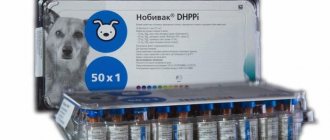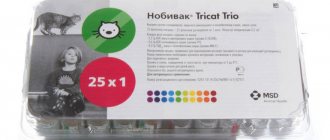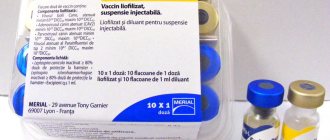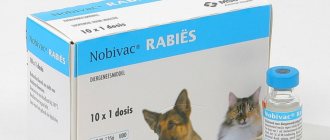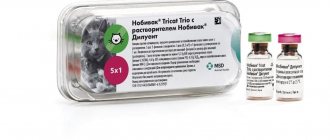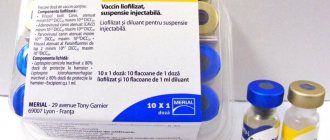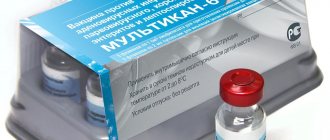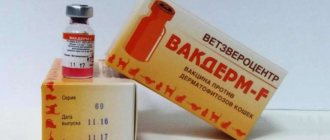The Nobivac vaccine is popular among dog lovers for a reason. Animals generally tolerate it well, the price remains reasonable. Vaccination saves you from many serious diseases, and yet there are reviews on the Internet about various problems: adverse reactions to some batches of the composition are not excluded. We offer a complete review of the Nobivac vaccine for dogs to stop worrying and make the right choice.
Nobivak line of drugs
global $ads_google; //data-ad-slot=”2475549904″ $ads_google = empty($ads_google) ? false : true; ?> if ($ads_google == false) {?>
$ads_google = true; ?> } ?>
The Nobivak vaccine is produced by the Irish veterinary company MSD Animal Health, and in our country it is represented by the Intervet branch. They produce 8 types of vaccines to develop immunity against a number of diseases.
To dilute the product, you need a sterile Nobivac Diluent phosphate buffer solution. The Nobivak line includes items adapted for dogs of different ages.
Types of vaccine:
- Rabies
for protection against rabies;
- R.L.
against leptospirosis and rabies;
- L4
and
Lepto
for leptospirosis; - Puppy DP
antiplague, as well as for protection against parvovirus enteritis;
- DHP
and
Nobivak DHPPi
to suppress adenoviruses, canine distemper, DHPPi also has a suppressed parainfluenza virus; - KC
helps prevent bordetellosis, parainfluenza and infectious tracheobronchitis.
Storage conditions, price in the Russian Federation
They do not lose their properties at a temperature of 2 - 8 degrees (usually in the refrigerator). Use is allowed within two years from the date of manufacture. Use immediately after opening. Storage in an open bottle is not allowed; if necessary, the drug is immediately disposed of.
Below is the average cost of one bottle of each drug in Russia:
- DHPPi - 170 rub.;
- Lepto – 75 rub.;
- Pappy DP for plague and parvovirus enteritis – 250 rubles;
- Rabies vaccination (Nobivak Rabies) – within 180 rubles;
- For rabies and leptospirosis Nobivac RL – about 120 rubles.
Prices are affordable, so it will not be difficult for owners to protect their pet from unwanted illnesses.
Indications for use
Vaccination with Nobivac is needed against the following diseases:
- leptospirosis;
- parvovirus enteritis;
- rabies;
- infectious hepatitis;
- carnivore plague;
- parainfluenza;
- bordetellosis.
The viral agents in the vaccine are very weakened in order to cause disease, but they successfully form a decent immune response in the allotted time.
The immune reaction is such that the antibodies formed by the body not only kill the infection introduced with the vaccine, but will also actively fight in the event of a new serious infection.
What is Nobivak for dogs
The Nobivak vaccine for dogs helps create protection against diseases in the animal’s body. The drug contains inactivated viruses that stimulate the immune system, allowing the immune system to study pathogens, find ways to counteract them and prepare for their possible invasion. If a dog does become infected with the virus, everything in its body will be ready to produce antibodies.
Vaccinations are given according to the plan developed by the veterinarian. If you intend to install them yourself, you need to follow the sequence. First, mandatory vaccinations against hepatitis, distemper and rabies are given. Other vaccines are recommended based on the epidemiological situation in the area where the animal lives. Then you can additionally get vaccinated against influenza, respiratory viruses and bordetellosis.
Release form and composition
Let's go through the features of each drug. We will not detail exactly how many strains are contained in each vial, but instead will look at the form in which different vaccines come.
Nobivac DHP and Nobivac DHPPi
The development consists of live attenuated canine distemper viruses. In addition, the composition contains infectious hepatitis and canine parvovirus infection.
The veterinary pharmacy sells a lyophilized white vaccine. The composition is dissolved with the above-mentioned phosphate buffer solution or with the liquid vaccine Nobivak RL or Rabies, Lepto. The medicine is released in a glass container, hermetically sealed with a rubber stopper with an aluminum run-in. One box contains 10 bottles.
A clinically healthy dog is suitable for vaccination. The age of first vaccination is 8-9 weeks. The next injection is given at 12 weeks.
Revaccination is carried out annually. Only one dose of Nobivak DHPPi is needed per animal.
The drug Nobivak DHPPi is administered subcutaneously.
global $ads_google; //data-ad-slot=”2475549904″ $ads_google = empty($ads_google) ? false : true; ?> if ($ads_google == false) {?>
$ads_google = true; ?> } ?>
Store the bottle in a place protected from light, the permissible temperature range is 2-8 degrees. The solvent is stored at a temperature of 18°C-23°C. The shelf life of the product is 2 years.
A variation of DHP is also used to vaccinate pregnant bitches.
Lepto (Nobivac Lepto)
We present a liquid inactivated bivalent vaccine in the form of a glass bottle under a rubber cap rolled in aluminum. They sell 10 bottles in a pack. One dose contains a sufficient amount of inactivated leptospirosis bacteria, which will protect the dog from both carriage and clinical manifestations.
The first vaccination is given to any breed at 8-9 weeks, the second after 3 weeks. Revaccination with one dose is indicated annually. Injected subcutaneously.
Puppy DP
The bottle contains an attenuated vaccine containing a culture of canine distemper virus and parvovirus. The product is produced in a lyophilized white form. Solvent - Diluent.
Only a healthy puppy is vaccinated at 4-6 weeks, then a subsequent manipulation is carried out 2-3 weeks later, but with the DHP or DHPPi variety.
Rabies (Nobivak Rabies)
One dose is shocking and is valid for another three years from the date of administration. The vial contains a sufficient amount of inactivated rabies virus. The medication looks like a pink liquid suspension.
The dog is vaccinated with Rabies at 12 weeks.
RL (Nobivak RL)
Rabies and leptospirosis will not resist the inactivated vaccine in the form of a pinkish or ocher liquid.
The first vaccination is indicated at 12 weeks; if early protection is needed, this can be done at 9 weeks, and again after 3 weeks. The immunity will work for another year against leptospirosis and three years against rabies.
KC (Nobivak KS)
It is presented as a lyophilisate, on the basis of which an intranasal solution is prepared. The vaccine is based on VERO cells infected with canine parainfluenza and bordetellosis culture, as well as excipients.
global $ads_google; //data-ad-slot=”2475549904″ $ads_google = empty($ads_google) ? false : true; ?> if ($ads_google == false) {?>
$ads_google = true; ?> } ?>
The CS consists of a vaccine and a solvent in vials.
L4 (Nobivak L4)
Another effective inactivated medicine from Dutch developers in the form of a suspension. Only healthy dogs are allowed to be vaccinated.
Nobivac Rabies
A vaccine designed to protect a pet from rabies . It contains killed viruses grown in an artificial environment. It looks like a ready-made suspension of yellowish color. The solution is administered at 3-12 months for the first time and repeated every three years. Moreover, the effect begins after 3 weeks , and the drug works for up to 36 months . In particularly dangerous conditions (with a high incidence of disease in the region), annual vaccination is permitted.
The average cost is 180 rubles . The total price of a specialist’s work is 350-500 rubles .
Instructions for use Nobivac
The vaccine is injected subcutaneously into the withers. These are Lepto, PuppyDP, DHPPi, RL, L4, DHP. Rabies requires intramuscular administration, and CS is dripped into the nose.
Nobivak vaccination is done according to the schedule recommended by veterinarians and only to clinically healthy dogs. Procedures are allowed for pregnant dogs and small puppies.
It is still recommended to trust the veterinarian in matters of administration, who will do everything correctly.
You can master the vaccination procedure yourself at home, but it is important to strictly follow the instructions for the medication. For a liquid suspension, everything is simple: it is drawn into a syringe and injected into the dog.
The powder is diluted to a homogeneous liquid state by mixing it with a solvent and shaken thoroughly before injection. Both before and after the insertion site is treated with an antiseptic without fail.
It is prohibited to mix different vaccines in one syringe!
It happens that two vaccines are needed at the same time. They still don’t pour them into one syringe - they take different ones and inject them into different places too.
In case of an allergic reaction to the previous drug, the dog is given an antihistamine an hour and a half before the scheduled vaccination.
Why is vaccination important?
Vaccinations cannot be ignored. Only vaccination gives puppies a chance to survive distemper. The canine distemper virus attacks the nervous, lymphatic, digestive systems, and bone marrow of a small pet. The disease is characterized by a severe course: the mortality rate of puppies under 3 months of age from distemper is almost 100%.
Infection occurs through the digestive tract, then the virus quickly spreads through the bloodstream to all tissues. You can become infected from already infected animals, through care items, bowls, and bedding.
Weakened animals with low immunity primarily fall ill. Predisposing factors are also:
- poor living conditions;
- frequent colds;
- unbalanced diet;
- lack of vitamins and others.
With distemper, the incubation period lasts up to three weeks, and at this time the dogs are already contagious. The disease can appear suddenly: yesterday’s playful puppy today cannot get up from the litter, and the following are observed:
- high temperature - up to 40-41 degrees;
- refusal to eat;
- vomit;
- weakness, lethargy, fatigue;
- deterioration in the appearance of the coat.
A little later, the nervous system is affected, and convulsions may occur.
Important! The plague virus is insidious and tenacious! It can be stored indoors for up to a year and can even withstand disinfection treatments. After the death of a pet from distemper, it is not recommended to immediately take a small puppy into the home.
There are no specific cures for distemper; veterinarians prescribe symptomatic treatment and drugs to strengthen the immune system. Animals with high immunity have a higher chance of survival. Vaccinated puppies tolerate the disease much easier, without dangerous consequences.
Practice shows that in rare cases, vaccination against distemper is ineffective. There may be several reasons:
- deworming was not carried out before vaccination;
- the puppy is already infected with the virus, the disease is in the incubation period, and the vaccine provokes the development of the disease;
- a low-quality vaccine was used, so it is not recommended to vaccinate yourself.
Parvovirus enteritis affects only dogs; the disease is not typical for cats. The disease is acute; a pet that has been in contact with a sick animal or contaminated care items can become ill. Humans can also be a carrier of the virus.
Enteritis is characterized by an acute course, the disease develops rapidly: the incubation period lasts from several hours to several days. The virus primarily does not spare the digestive system: it destroys its mucous membrane, which causes vomiting, diarrhea and bleeding. Possible heart damage. The disease often ends in death.
Nobivak will not be able to completely protect animals from infection with parvoviruses, however, vaccinated animals tolerate the disease much more easily and have a good chance of recovery.
False rabies (Aujeszky's disease) has a high mortality rate. A dangerous virus can enter the body from a sick animal, common objects, or consumption of raw meat. A tenacious virus is destroyed only at a temperature of +100°C.
The disease is characterized by the following symptoms:
- first a decrease in appetite, then a complete refusal to eat;
- irritability, anxiety;
- severe itching;
- increased salivation.
Two days later, brain damage begins, paralysis of the larynx is observed, which leads to death. The dog “fades away” within 48 hours, leaving no opportunity for treatment. The only salvation can only be vaccination.
Nobivak helps prevent another dangerous disease, which in 90% of cases leads to the death of puppies. Parvovirus enteritis affects the lymphatic system, lymphocytes and red blood cells. The spleen, heart muscle, and other organs suffer.
The latent period of the disease lasts 1-2 weeks, the manifestation of symptoms is characterized by:
- increased temperature;
- refusal to eat;
- vomiting;
- diarrhea;
- weakness.
For treatment, immunostimulating drugs, vitamin complexes, and antibiotics are prescribed. Vaccination with Nobivak will help prevent infection that causes the death of puppies.
Vaccination against rabies will help prevent the death of your pet, since the mortality rate from it is 100%. The disease may not manifest itself for a long time—up to a year—and you can become infected after being bitten by a sick animal.
Contraindications
The most important contraindication for the entire Nobivak series will be the time of the first vaccination: they are prohibited until the puppy is 8 weeks old, for Puppy DP until the age of 1 month.
Vaccinations are not given if:
- the animal is currently sick or weakened;
- already infected with this disease;
- deworming has not been done (it is carried out 8-10 days before vaccination). This is due to the fact that internal parasites seriously reduce the strength of the immune system;
- increased sensitivity to the components of the drug has been identified - it is better not to experiment and resolve this issue with a doctor;
- if damage to the bottle is noticed or it is obvious that the contents are spoiled, the container with the medicine must be disinfected. Boil the bottle with the composition for 10 minutes and throw it away. This must be done; you should not give even weakened viruses a chance to escape into the wild;
- the dog's ears and tail have just been docked;
- teeth change;
- mating is planned.
Answers to frequently asked questions
Which vaccines should always be given and which ones can be “omitted”?
Vaccination against the rabies virus is required by law (Nobivac Rabies is used). Also, when selling kennel puppies, moving, or participating in exhibitions, vaccination against canine distemper, infectious hepatitis and parvovirus enteritis is required (use polyvalent DHP, DHPPi, Puppy DP). Whether to administer serums for parainfluenza, leptospirosis and bordetellosis (Lepto, L4, KC) is decided by the owner together with the veterinarian, based on the epidemiological situation in the area.
Is it necessary to undergo quarantine after vaccinations and how long does it last?
Yes, this requirement is strictly observed. During quarantine, the so-called period of immune gap: when protection from the old vaccine is no longer effective, and from the new one has not yet developed. Its duration differs for different types of vaccines: from 3-10 days to 2-3 weeks, the standard duration is 14 days. It is prohibited to walk a dog (especially a puppy), or to have contact with sick, stray animals, or pets whose vaccination you are not sure of.
Is it possible to vaccinate pregnant and recently given birth dogs?
Almost all Nobivak vaccines are safe for pregnant and lactating bitches. The only exceptions are Lepto and RL: they cannot be placed 2 weeks before and within 21 days after birth.
The instructions indicate that Rabies protects your pet from rabies for 3 years. But I heard that vaccinations are done annually. How often should this vaccine actually be given?
Rabies actually prevents a dog from contracting rabies for up to 3 years. But in Russia, annual vaccination of animals against this virus is mandatory. Therefore, if you and your dog participate in exhibitions and sports competitions, or regularly travel outside the city/country, get vaccinated in accordance with the law: there will be no harm from more frequent vaccinations. If the animal is just a pet, it is enough to install Rabies once every 3 years.
Side effects
global $ads_google;
//data-ad-slot=”2475549904″ $ads_google = empty($ads_google) ? false : true; ?> if ($ads_google == false) {?> $ads_google = true; ?> } ?> Minor and temporary side effects are allowed. They do not require special care or a visit to the veterinarian. The dog may be lethargic and drowsy for some time after the vaccine is administered. Sometimes the temperature may rise, but only slightly.
In addition, in rare cases, the dog may experience diarrhea and vomiting, and the injection site may become slightly thicker and redden.
For the CS form, side effects include the appearance of swelling, nasal discharge, disturbances in breathing processes, and a rash on the face.
The animal is monitored: if fever, convulsions, increased salivation with foam suddenly appear, then they immediately contact the veterinary clinic.
Preparing your pet for vaccination
Preparation for vaccination with Nobivak depends on whether it is a puppy or an adult dog.
If an unvaccinated puppy comes into the house, we don’t waste time - parvovirus will not wait, just like canine distemper (everyone is used to calling it “distemper”) and other infectious diseases.
A decent breeder will always indicate at what point anthelmintic treatment was carried out. If about 13-14 days have passed after flea treatment, and no more than 9-10 days have passed after antihelminthic measures, the puppy can be vaccinated. If the deadlines are missed, antiparasitic treatment is carried out.
Flea drops are selected according to the age and weight of the baby in strict accordance with the recommendations on the packaging.
After carrying out the anti-flea manipulation, you need to give the puppy something anti-helminthic. After 5-7 days, observe the feces. If there are no worms, vaccination is carried out. If a helminthic infestation is detected, the vaccination is temporarily canceled - re-treatment is necessary. If after 4-5 days there is “silence” and no parasites are visible, you can go and get vaccinated.
It is much easier to prepare an adult dog - it is already vaccinated against many diseases. It’s not a big deal if the date is pushed back by a month for some reason; on average, the vaccine is designed to last for a longer period of 14 months.
If the animal does not have fleas, then it is “wormed” 10 days before the selected date. Watching and waiting. If there are no parasites, you can get a vaccine.
Reviews
Lisa: “Last year I vaccinated my two dogs with Nobivac. First complex, then from rabies. The pets tolerated all the injections normally, with no side effects, loss of appetite or well-being. The drug worked with a bang: the neighbor’s dog, with whom mine constantly communicate, fell ill with distemper, but this dirty trick bypassed us.”
Anna: “I have a very timid dog, he hates injections, and constantly throws tantrums. But he tolerates Nobivac injections calmly. After the vaccination, his health does not change: no drowsiness, he eats and plays as always. Excellent inexpensive product."
Nadezhda: “I’ve been vaccinating my dog with Nobivak for four years now. It’s a high-quality drug, the dog always tolerates it well, our vet uses only this vaccine.”
Olga: “I have extensive experience in keeping animals - from dogs to ferrets. I always vaccinated everyone with Nobivak. Now there are two huskies living in the house: workers, for hunting. The eldest dog is already 11 years old. And during all this time I have never fallen ill with infectious diseases, and always tolerate vaccination well.”
Igor: “A good friend’s dog died after being injected with Nobivac. Half an hour later, a terrible allergy appeared, the puppy was swollen to the point of a balloon. We turned around halfway home and back to the clinic, but we couldn’t save the animal.”
Lily: “I have a Yorkie puppy. We did the first vaccinations ourselves, because... We were given a kitten that was not vaccinated. I was terribly worried, carefully chose the drug and settled on Nobivak. The baby tolerated both vaccinations well: he slept a lot, tried to reach the injection site (apparently it was itching), but he ate well.”
Preparation and use of the vaccine
It is better to do the injections for the first time not by yourself, but by the hands of a veterinarian. It will be much easier for him to calculate the correct dose according to weight. The doctor will also conduct an examination and determine whether the animal is healthy and whether its body is ready for such manipulation. This is also recommended due to a possible allergic reaction. In this case, a specialist will be able to help, but the owner may become confused and miss the moment when the symptoms can be stopped without problems.
But you can re-vaccinate yourself at home. If it is an injection, you need to learn how to inject your dog.
First, antiparasitic treatment is also carried out 10 days before the selected date. Otherwise just follow the instructions:
Open the container with the dry component;
- 1 ml of Diluent is poured into the bottle;
- Close the container and shake well several times - the solution should be extremely homogeneous;
- Draw the required amount of the composition into the syringe, remove excess air, change the needle to a sterile one;
- The skin on the dog's withers is pulled back and a needle is inserted;
- The dose is administered and the area is then massaged.
As for the type of CS, it is not at all difficult to give it to your pet, because it is not an injection. After dilution, the drug is instilled into the nostril with the nozzle that comes with the kit.
Learn about essential drugs in animals
- Use of Dirofen in cats
- Instructions for using Vetom in cats
- Instructions for using multifel in cats
- Instructions for use of fosprenil in cats
- Instructions for the use of Kotervin in cats. The breadth of the anti-inflammatory, saluretic effect of Cotervin for the complex treatment of many pathologies in cats
- Instructions for use Kot Bayun in cats
- Instructions for the use of feliferon in cats
- Stronghold in cats
- Instructions for use of Milbemax in cats
- Provides information about the drug gamavit
- Instructions for the use of spirovet in animals. Calculate the optimal dose of the drug in dogs, cats, pigs, cows, sheep, goats
- Instructions for the use of tiamulin in birds and animals
- Instructions for use of Sevaxel in animals
- Instructions for use of thiam-oxy in animals
- Instructions for the use of tetravet in animals
- Instructions for use of TAF 25% in chickens, turkeys and other animals
- Instructions for use of cefkinome in animals
- Instructions for the use of intramycin in animals
- Instructions for the use of inotil in animals. Calculate the optimal dose of the drug in dogs, cats, pigs, cows, sheep, goats
- Instructions for use of cobactan in dogs
- Instructions for the use of coliside in animals. Calculate the optimal dose of the drug in birds, pigs, cows, sheep, goats
- Instructions for the use of Marbox in animals. Calculate the optimal dose of the drug in dogs, cats, pigs, cows, sheep, goats
- Instructions for the use of inosel in animals. Calculate the optimal dose of the drug in dogs
- Instructions for the use of oxytetra in animals
^Top
Average price for Nobivak
global $ads_google; //data-ad-slot=”2475549904″ $ads_google = empty($ads_google) ? false : true; ?> if ($ads_google == false) {?>
$ads_google = true; ?> } ?>
The cost in Russia is per dose. The veterinary pharmacy will immediately clarify the dimensions of the animal and recommend adjusting the dosage, if necessary. All prices are for autumn 2020.
- Lepto
— 150-200 rub.
- Rabies
—130-150 rub.
- R.L.
—200-240 rub.
- L4
— 260-300 rub.
- Puppy DP
— 280-350 rub.
- DHP
— 290-320 rub.
- DHPPi
— 600-700 rub.
- KS
— 750 rub.
Diluent component
costs about 50 rubles per ampoule.
Kinds
produces the following vaccines against particularly dangerous diseases of pets:
| Name | Against what diseases | Who is it intended for? |
| Bb | Bordetellosis | Cats |
| Ducat | Rhinotracheitis, calicivirosis | Cats |
| Tricat Trio | Rhinotracheitis, calicivirosis, panleukopenia | Cats |
| D.P. | Plague, parvovirus enteritis | Puppies 4–6 weeks |
| DHP | Plague, parvovirus enteritis, adenoviral hepatitis | Puppies over 8 weeks and adults |
| DHPPi | Plague, parvovirus enteritis, adenoviral hepatitis, parainfluenza | Puppies over 8 weeks and adults |
| Lepto | Leptospirosis | Dogs |
| R | Rabies | Cats, dogs |
| LR | Leptospirosis, rabies | Dogs |
| KC | Bordetellosis, parainfluenza | Dogs |
Analogs
Despite the great demand for Nobivak, someone still has to buy its analogues. It’s just not always possible to find the right name in a veterinary pharmacy. You can replace one drug with a similar one if it contains the same viral cultures.
Several foreign vaccines are purchased, similar in strain to Nobivak. We are talking about Vanguard, Hexadog, Eurikan and Rabizin.
There are also Russian analogues that are just as effective in quality, but at a much lower cost. A number of items are also in demand. These are Hexakanivac, Dipentavak, Multikan.
Which is better for dogs: Nobivak or Eurikan?
"Eurikan" is the trade name of the French vaccine series. There are two varieties in the series, one with a strain of rabies, the second without it.
Eurikan DHPPI+2L is used for vaccination of adult dogs and puppies over 8 weeks of age. Revaccination is carried out with a composition containing the rabies virus. Next, the injection schedule is calculated simply: the drug is administered once a year.
This vaccination is also against a number of diseases; the list includes plague, enteritis, hepatitis, leptospirosis, parainfluenza, and rabies.
Eurikan or Nobivac - which is better? This question is often asked by lovers of barking four-legged animals. In fact, the answer is quite simple: Nobivak is not always available at the veterinary pharmacy, but Eurican is easier to get.
"CoviVac"
The drug became the third Russian vaccine against coronavirus; it was created at the Chumakov Center in Moscow.
CoviVac contains the SARS-CoV-2 virus itself. But this virus cannot infect humans, since it is inactivated and is not able to reproduce in the human body. The same technology is used for the production of the polio vaccine.
Who can I bet on?
The drug is suitable for vaccination of people from 18 to 60 years of age. CoviVac has not yet completed phase 3 clinical trials. After it, the effect of the vaccine on patients over 60 years of age will become known. The tests will be completed in June.
At the same time, trials will be conducted for people with cancer and autoimmune diseases, as well as chronic obstructive pulmonary disease.
Contraindications for vaccination
CoviVac, like the other two vaccines, cannot be used for severe forms of allergies in a patient. In case of exacerbation of chronic diseases, vaccination should also not be given. It will be necessary to delay vaccination due to acute infectious or other diseases.
The drug is contraindicated in people who have seizures or fevers, or who have had an acute reaction to other vaccines.
Interval between vaccinations
CoviVac consists of two components. For full protection, you need to get two vaccinations. Unlike Sputnik V, EpiVacCorona, the interval between drug administration is much shorter and is 14 days instead of 21.
When will antibodies appear?
Accurate information will be available after the third phase of clinical trials.
